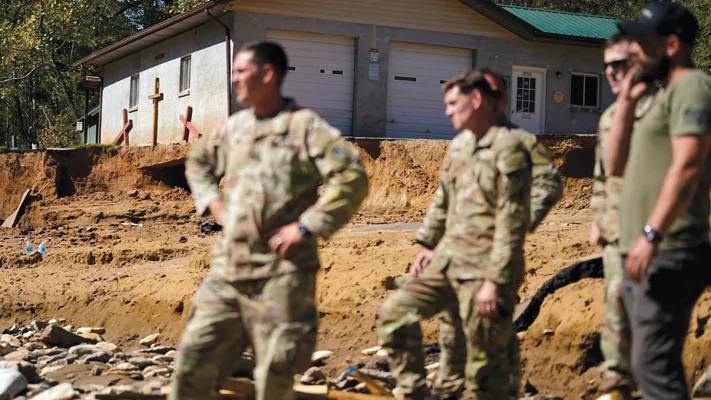In the devastating aftermath of Hurricane Helene in the North Carolina mountains, the plethora of anecdotal reports from family and friends are full of gratitude for an abundance of both public and private assistance.
My cousin Macon Thoma, a healthcare worker living in the heavily damaged town of Black Mountain, reported on Facebook in the week after the storm that help on her post-storm commute to work is so great that “sometimes it makes me cry.”
She wrote: “Today’s count during that 10 minutes or so of interstate time early in the morning: 31 crane trucks (some from electric companies, some tree companies). 4 tankers labeled potable water. 3 propane trucks. 2 tankers of gas. 1 well-driller. 3 Red Cross disaster relief vans. 7 Penske trucks (truck of choice for private groups bringing in aid). Police & fire department escorts for some of the above. 1 FedEx truck. 1 UPS truck. More dump trucks than I could count. Private grading & contracting company trucks. LOTS of yellow iron.”

And: “Y’all, I have co-workers who are arranging bulldozer rides so they can get to areas to see their patients. They are giving each other directions on how deep the creeks are & how tall their boots need to be to cross to carry in supplies to people. … There are helicopters zig-zagging overhead all day long, hauling supplies to areas that still can’t be reached by road. There are mules taking supplies up impassable roads. It’s going to take a long time. But the helpers are here.”
From all the stories I hear, there’s no anger, only gratitude, for the efficacy of all levels of support, including federal, and with the National Guard doing yeoman’s work. There certainly is no sense of the sheer incompetence the Federal Emergency Management Agency showed after the Gulf Coast’s Hurricane Katrina in 2005 (although even then, the Coast Guard was astonishingly heroic, as were state and federal wildlife officials helping people escape the floods). Considering that the inland damage is so much worse even than the destruction caused by torrential rains from the remains of 1969’s Hurricane Camille, what really astonishes is not the lack of relief but the effectiveness of it.
And it all seems buttressed by neighbors helping neighbors or strangers helping strangers. Forget the politics, pro and con: Americans are at their best in crises when they mix public and private aid with pluck, ingenuity, and resourcefulness. That’s the sort of attitude that created the famous Cajun Navy, an organization also very present today in North Carolina, after Katrina.
Consider Macon’s brother Leland, an outdoorsman of considerable note, in a text message just two days after Helene. He lives near Swannanoa, one of the worst-hit towns of all, where people were rescued from rooftops via kayak.
“We’re OK, just stranded due to the bridge being out to our valley,” he wrote. “Going to try to rally the neighbors to build a bridge today.”
Yeah, that’s all: Just rebuild a bridge!
CLICK HERE TO READ MORE FROM THE WASHINGTON EXAMINER
Two days later, a progress report: “We built the bridge Sunday and evacuated some really old folks who could barely walk. Then we got a full-on miracle yesterday when a badass private grading company from 1 1/2 hours away showed up and rebuilt our road in about 2.5 hours.”
That, that, is what real disaster recovery looks like: personal initiative combined with serendipitous blessings, backed by community spirit with truckloads of physical and metaphorical grace.
